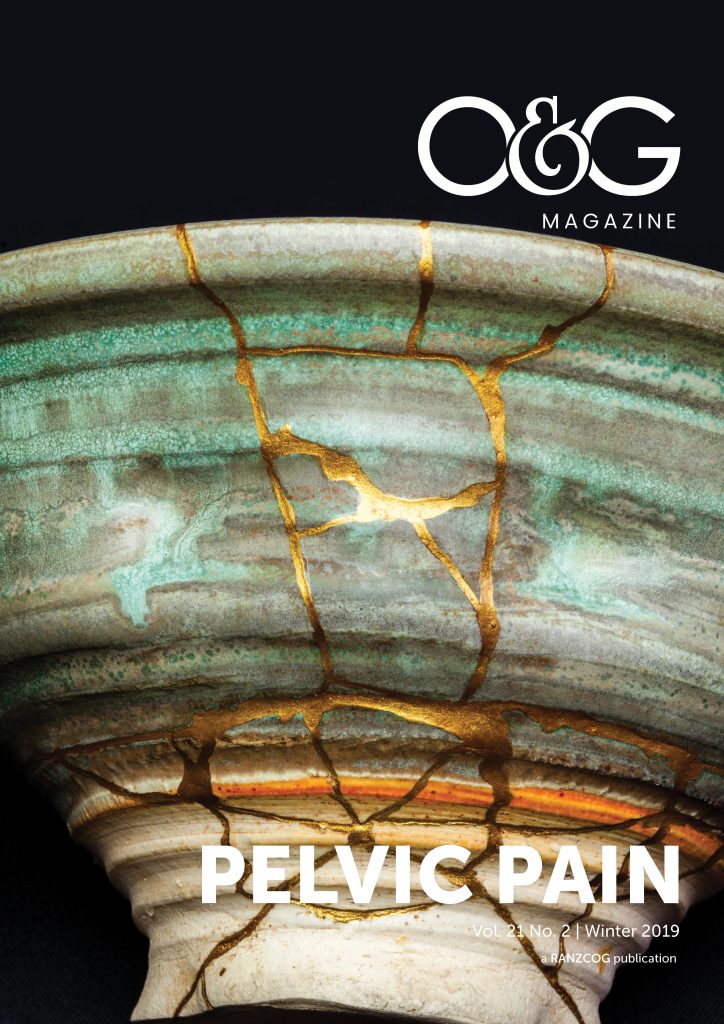Persistent pelvic pain (PPP) is considered one of the most complex and difficult pain conditions to treat.1 Like most forms of persistent pain, PPP can have a profound impact on many aspects of life and functioning, affecting a woman’s identity, ability to be intimate and the capacity to reproduce and care for children. Specific underlying causes of pelvic pain can be difficult to detect, and even where lesions, scarring, or inflammation are found, effective treatment is difficult. In a qualitative study with women experiencing medically unexplained disorders, Werner and Malterud2 showed that women often feel a sense of shame and disempowerment as they struggle to search for a satisfactory diagnosis. Moreover, as with other conditions with unclear medical aetiology, there is a high prevalence of prior trauma, including childhood sexual abuse, and co-morbid psychiatric disorder, which add to the consequences of PPP for quality of life.3
In recognition of the complexity of most pain conditions, including PPP, it is not surprising that a range of psychological approaches to their treatment have been suggested. The best evidence exists for cognitive behaviour therapy (CBT). The fundamental principle of CBT is that the interpretation of events (the cognition) shapes emotional reactions and subsequent behaviour. Applied to persistent pain, this can help to understand the cycles of avoidance and distress that can arise; a woman may experience an exacerbation of pain, giving rise to the thought that ‘the pain is unbearable’. This kind of thinking is sometimes referred to as ‘pain catastrophising’ and is known to predict a poor response to treatment.4 As a consequence, she decides to stay home from work, which reinforces the belief that the pain is indeed unbearable. Meanwhile, she feels guilty that she has stayed away from work and misses out on the social interaction that this could have provided, which in turn, lowers her mood. Lower mood leads to lower pain tolerance, and a reduced sense of self-worth. CBT seeks to intervene at a number of points in this cycle, using interventions such as pain education, relaxation, coping skills, imagery techniques, goal setting, pacing, and challenging unhelpful thoughts. Increasingly, approaches such as mindfulness-based stress reduction or acceptance and commitment therapy (ACT) are also being used, either to supplement more traditional CBT or as approaches in their own right. With all these approaches, the goal is that the patient develops a ‘toolkit’ of skills and strategies that enable them to manage their pain, rather than fight against it, and carry out valued activities more effectively.
Although there is a wealth of evidence supporting the efficacy of CBT in the treatment of musculoskeletal pain, the evidence for what works with PPP is more limited. A 2014 Cochrane review of non-surgical treatments for chronic pelvic pain5 found some evidence (albeit in low- or very low-quality studies) for reduced reporting of pain in women who had undergone reassurance ultrasound scans and received counselling, and in women who had taken part in writing therapy as a form of emotional disclosure. Two very small recent studies have reported some benefits for mindfulness interventions, and one of the better quality studies in the literature found that interpersonal therapy (IPT) was beneficial in reducing depression, but not pain severity.6 This was a randomised controlled trial (RCT) with 61 participants, most of whom were African American, a rare example in this field of an RCT and a study conducted with non-Caucasian participants. IPT is a time-limited psychotherapy that focuses on interpersonal issues associated with both the onset and maintenance of depression, and for this study was modified to incorporate pain-related content.
Why are these outcomes so disappointing?
Firstly, it is likely that a multidisciplinary approach is more effective than psychological interventions alone.7 Secondly, as Panisch and Tam3 noted, very few interventions for PPP address the history of trauma, which, arguably, will reduce their efficacy by neglecting to address underlying causes of distress. Thirdly, almost all the studies we reviewed have very small numbers of participants and are weak methodologically. This area of research may attract unusual approaches to treatment. For example, Meissner and colleagues8 reported on the efficacy of an intervention combining the following disparate elements: mindfulness-based psychotherapy, hypnotherapy, problem-solving therapy and CBT, together with ‘techniques of somatosensory stimulation from traditional Chinese medicine such as acupuncture, moxibustion (heat), and cupping’.9
What’s the way forward for psychological interventions for PPP?
One striking feature of the studies reviewed is the absence of the voices of the women for whom these treatments have ostensibly been designed. We know very little about what women themselves find useful. We do know that some women react negatively when doctors recommend psychological therapies to them, because they feel that this means that treating clinicians don’t believe their pain is real.10 Others are reluctant to attend psychological therapy because of the stigma attached to undergoing therapy and potentially being labelled with a mental illness. In addition, many PPP patients suffer reduced mobility and find it difficult to consistently attend treatment sessions.
As part of a study in which we designed an app to help women manage their pelvic pain, we sought to overcome our lack of knowledge about what women themselves want by running a series of focus groups. We wanted to understand how they felt about receiving psychological therapy, and if they were open to receiving it via technological means. We found that the patients responded positively to the CBT and mindfulness exercises we presented and appeared open to using psychological strategies. Some reported helpful experiences with psychologists in the past, and some were already aware of how their mental states affected their experience of pain. Consistent with the literature, some women reported that they were reluctant to engage in psychotherapy, citing stigma, cost and lack of time as reasons.11 Others were concerned about being labelled with a psychological condition that may limit medical treatments, while others feared the distress of being told that their pain was ‘all in their mind’.
Based on the information gathered, we built a mobile phone app that we called appEASE. Pilot data indicate that more than 50 per cent of participants experienced clinically significant reductions in pain catastrophising and clinically significant increases in pain self-efficacy. Participants reported that by learning to cope more adaptively with pain, they were more confident doing the things they needed to do despite experiencing pain, and they attributed gaining new ways of thinking and coping from their use of the app. Other features of the app highlighted by women as particularly useful were the session on self-compassion and the sense of connection with the narrator of the sessions, suggesting that even in technology-based interventions a therapeutic relationship is important.
What can the clinician take away from our current understanding of the psychological contributions to the treatment of PPP?
Firstly, our evidence base is poor, and we have, by and large, neglected to ask women themselves what they need. Our own data suggest that women experiencing PPP sometimes feel misunderstood, but are open to psychological interventions, and should be involved in their design. Standalone psychological interventions may have a place but are likely to be more effective when integrated with interdisciplinary care that includes a gynaecologist and physiotherapist. Secondly, our study found that women experiencing PPP can feel a sense of failure, exacerbated by inconclusive diagnostic processes, so an orientation towards self-compassion may be particularly relevant for this population and their treating clinicians. Finally, much remains to be learned about how best to help this diverse, but often troubled, group of women.
References
- P Latthe, M Latthe, L Say, et al. WHO systematic review of prevalence of chronic pelvic pain: a neglected reproductive health morbidity. BMC Pub Health. 2006;6(1):177.
- A Werner, K Malterud. It is hard work behaving as a credible patient: encounters between women with chronic pain and their doctors. Soc Sci Medicine. 2003;57:1409-19.
- LS Panisch, LM Tam. The role of trauma and mental health in the treatment of chronic pelvic pain: A systematic review of the intervention literature. Trauma, Violence, & Abuse. 2019. https://doi.org/10.1177/1524838018821950.
- C Allaire, C Williams, S Bodmer-Roy, et al. 2018. Chronic pelvic pain in an interdisciplinary setting: 1-year prospective cohort. Am J Obstet Gynecol. 2018;218:114.e1-12.
- Y Cheong, G Smotra, AC Williams. Non-surgical interventions for the management of chronic pelvic pain. Cochrane Database of Syst Rev. 2014;(3):CD0087972014.
- E Poleshuck, S Gamble, K Bellenger K. Randomized controlled trial of interpersonal psychotherapy versus enhanced treatment as usual for women with co-occurring depression and pelvic pain. J Psychosom Res. 2014;77:264–72.
- C Allaire, C Williams, S Bodmer-Roy, et al. 2018. Chronic pelvic pain in an interdisciplinary setting: 1-year prospective cohort. Am J Obstet Gynecol. 2018;218:114.e1-12.
- K Meissner, A Schweizer-Arau, A Limmer, et al. Psychotherapy with Somatosensory Stimulation for Endometriosis-Associated Pain: A Randomized Controlled Trial. Obstet Gynecol. 2016;128:1134–42.
- K Meissner, A Schweizer-Arau, A Limmer, et al. Psychotherapy with Somatosensory Stimulation for Endometriosis-Associated Pain: A Randomized Controlled Trial. Obstet Gynecol. 2016;128:1134–42.
- A Werner, K Malterud. It is hard work behaving as a credible patient: encounters between women with chronic pain and their doctors. Soc Sci Medicine. 2003;57:1409-19.
- C Rini D Williams, J Broderick, FJ Keefe. Meeting them where they are: Using the internet to deliver behavioral medicine interventions for pain: Using the internet to deliver behavioral medicine interventions for pain. Translational Behavior Med. 2012;2:82-92.







What a great article. Is the app available to the general public? Will the app collect data about how it reduces catastrophising as well as offer support to women?
Dear Katherine
I’m really glad you liked the article. We would love to make the app available to the public and we have had a quite a few people ask us about this. We are currently making some changes to the app and configuring it to be available on Android and Apple operating systems. So we aren’t quite there yet – but definitely working towards it.
Thank RANZCOG so much for promoting the above for International Gynaecological Awareness Day. I look forward as to how we can work in collaboration and create a voice for women to share their stories so we can all learn from one and other in the community